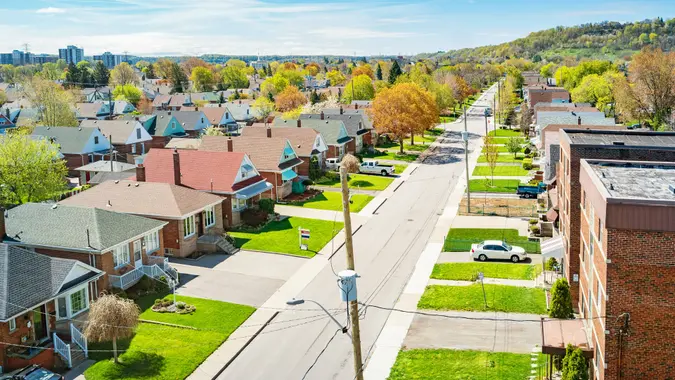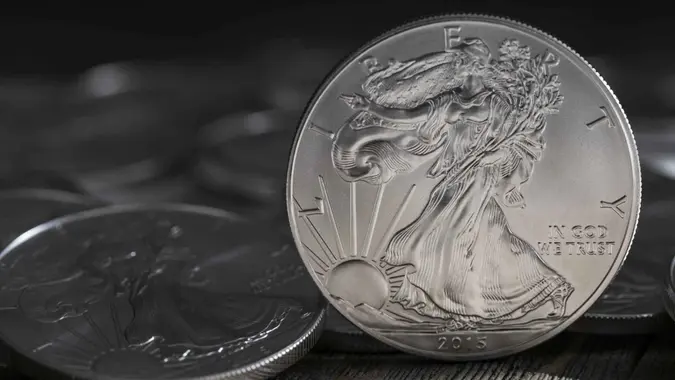Experts: What an Upper-Middle Class Income Could Look Like in 5 Years

Commitment to Our Readers
GOBankingRates' editorial team is committed to bringing you unbiased reviews and information. We use data-driven methodologies to evaluate financial products and services - our reviews and ratings are not influenced by advertisers. You can read more about our editorial guidelines and our products and services review methodology.

20 Years
Helping You Live Richer

Reviewed
by Experts

Trusted by
Millions of Readers
The American middle classes aren’t as clear-cut as they used to be, especially when it comes to the top income quintiles considered to be within the same social class.
It used to be that after you gained your educational attainment, you would get a job that you would work for 30 years, buy a house and then retire comfortably as you collect your pension. Presently, and probably moving forward, the financial paths aren’t as much of a straight line.
As of 2025, the upper-middle class in the United States is generally defined as households with incomes ranging from approximately $106,092 to $149,160, but to simplify for math’s sake, consider $100,000 to $150,000 to be an appropriate estimate. However, the American upper-middle class varies from state to state depending on several factors including proximity to popular cities, occupational status, household size and cost of living.
Family size, or the shrinking of it, also continues to play a role in how far an income can stretch. As household sizes evolve, the income needed to maintain an upper-middle-class lifestyle may change. For example, though a household with multiple children may require a higher income to achieve the same standard of living as a smaller household, those without children may be able to stretch and save their money differently.
This chasm between median household incomes among lower-income families to more affluent upper-middle-class individuals could grow wider in the future. Looking ahead to the next five years, there is a lot of political and economic volatility to account for, and there may be some big swings in all the markets, especially stock and real estate.
Here’s what financial experts are predicting.
Hyperinflation vs. Economic Growth
Inflation plays a crucial role in determining income classifications over time. Assuming an average annual inflation rate of 2% to 3%, which aligns with historical trends, you can anticipate that the dollar’s value will decrease, and income thresholds for different classes will rise to maintain the same purchasing power.
However, Robert Kiyosaki, author of “Rich Dad, Poor Dad,” has a stronger, if somewhat controversial, theory on how hyperinflation is heading toward the U.S. if the economy stays on the current trajectory. This means that American currency will become completely rejected by citizens as having any value, and the government will attempt to build confidence by printing more money.
Dark, but potentially avoidable, this theory puts into play how citizen and consumer perspectives will play a vital part in potential economic downturns over the next few years.
According to Kiyosaki, “There’s gonna be quadrillions of dollars coming back, and the ramifications of that are possibly… hyperinflation,” adding that, “this thing, [the U.S. dollar], goes to trash. This becomes toilet paper. This little dollar here. Because there’s so much of it out there.”
Unrealistic Demographics vs. Cost-of-Living Adjustments
The cost of living varies significantly across different regions of the United States. High-cost areas like New York City or San Francisco may require higher income thresholds to maintain an upper-middle-class lifestyle. As such, the income range for the upper-middle class may need to be adjusted upward in these areas to reflect the increased cost of living.
That being said, the cost of living could be a great leveler of social status. In fact, financial expert Grant Cardone thinks this will hopefully be a good thing in the future.
He said, “America should have the wealthiest middle class in the world, bar none!” However, he also noted, “Don’t be grateful for the middle class — be in a hurry to get out of it.”
This is an extrapolation from Cardone’s argument that the middle class shouldn’t exist. According to him, this demographic, which makes up the majority of American households, has been essentially hypnotized into complacency by a “myth” designed to keep people satisfied with less.
Waging Wage Wars
Changes in the economy and wage trends can also impact income classifications. If the economy experiences strong growth and wages rise faster than inflation, this could lead to higher income thresholds for the upper-middle class. However, even high earners can succumb to the living the paycheck-to-paycheck cycle.
Money expert, Suze Orman said, “The more money you make, the more money you spend. You spend it because you want to impress everybody because now you’re making six figures. I have found that people who make six figures really have less money than those who don’t. People just love to spend.”
If this trend continues in the future, even if you make a high enough salary to be considered part of the upper-middle class, it may do nothing to compete with your actual lifestyle. No matter what comfortable or lavish surroundings you buy, if you don’t have money in the bank, you don’t have much.
Final Take To GO
The bottom line is that while it’s challenging to predict with certainty what anything will look like in the next five years, or even further down the line. However, you can make a reasonable assumption that the upper-middle-class incomes will likely be higher due to inflation and potential economic growth.
More From GOBankingRates
- Nearly 1 in 3 Americans Hit by a Costly Holiday Scam, Norton Survey Shows -- How To Avoid This
- Here's What Retirees Wasted the Most Money On in 2025 -- and How To Avoid It in 2026
- How Middle-Class Earners Are Quietly Becoming Millionaires -- and How You Can, Too
- 6 Safe Accounts Proven to Grow Your Money Up to 13x Faster
 Written by
Written by  Edited by
Edited by 

























